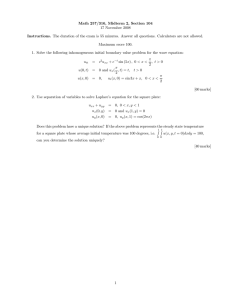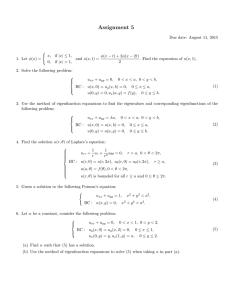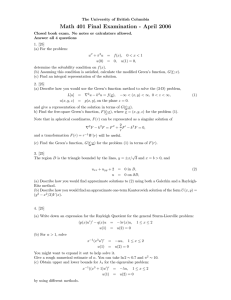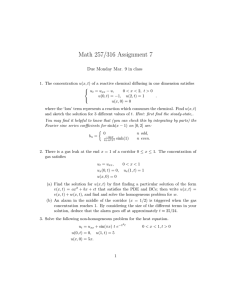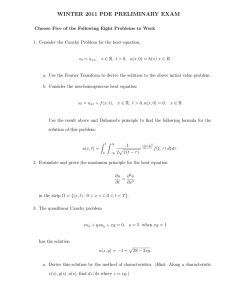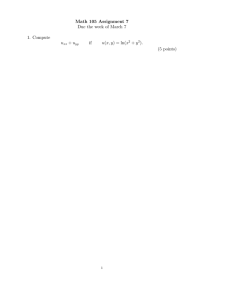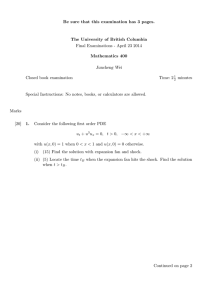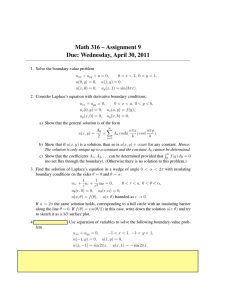Symbolic Computation of Conservation Laws of Nonlinear Partial Differential Equations Willy Hereman
advertisement
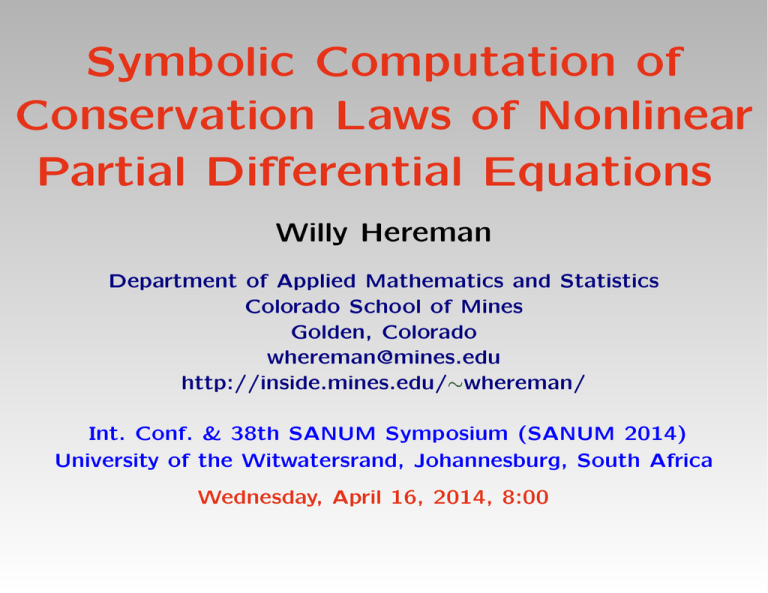
Symbolic Computation of
Conservation Laws of Nonlinear
Partial Differential Equations
Willy Hereman
Department of Applied Mathematics and Statistics
Colorado School of Mines
Golden, Colorado
whereman@mines.edu
http://inside.mines.edu/∼whereman/
Int. Conf. & 38th SANUM Symposium (SANUM 2014)
University of the Witwatersrand, Johannesburg, South Africa
Wednesday, April 16, 2014, 8:00
Acknowledgements
Douglas Poole (Chadron State College, Nebraska)
Ünal Göktaş (Turgut Özal University, Turkey)
Mark Hickman (Univ. of Canterbury, New Zealand)
Bernard Deconinck (Univ. of Washington, Seattle)
Several undergraduate and graduate students
Research supported in part by NSF
under Grant No. CCF-0830783
This presentation was made in TeXpower
Outline
•
Examples of conservation laws
•
The Korteweg-de Vries equation
•
Other scaling invariant quantities (KdV equation)
•
The Zakharov-Kuznetsov equation
•
Methods for computing conservation laws
•
Tools from the calculus of variations
• The variational derivative (testing exactness)
• The homotopy operator (inverting Dx and Div)
•
Application 1: The KdV equation
•
Application 2: The Zakharov-Kuznetsov equation
•
Demonstration of ConservationLawsMD.m
•
Conclusions and future work
•
Additional examples
I
Manakov-Santini system
I
Camassa-Holm equation in (2+1) dimensions
I
Khoklov-Zabolotskaya equation
I
Shallow water wave model for atmosphere
I
Kadomtsev-Petviashvili equation
I
Potential Kadomtsev-Petviashvili equation
I
Generalized Zakharov-Kuznetsov equation
Examples of Conservation Laws
Example 1: Traffic Flow
u = density of cars
a
b
x
Modeling the density of cars (Bressan, 2009)
u(x, t) density of cars on a highway (e.g., number of
cars per 100 meters).
s(u) mean (equilibrium) speed of the cars (depends
on the density).
u = density of cars
a
b
x
Change in number of cars in segment [a, b] equals the
difference between cars entering at a and leaving at b
during time interval [t1 , t2 ]:
Z
b
Z
t2
u(x, t2 ) − u(x, t1 ) dx =
a
!
Z
Z
b
t2
ut (x, t) dt
a
t1
J(a, t) − J(b, t) dt
t1
!
Z t2 Z b
dx = −
Jx (x, t) dx dt
t1
a
where J(x, t) = u(x, t)s(u(x, t)) is the traffic flow
(e.g., in cars per hour) at location x and time t.
Then,
R b R t2
a
t1
(ut + Jx ) dt dx = 0 holds ∀(a, b, t1 , t2 )
Yields the conservation law:
ut + [s(u) u]x = 0
or
Dt ρ + D x J = 0
ρ = u is the conserved density;
J(u) = s(u) u is the associated flux.
A simple Lighthill-Whitham-Richards model:
u
s(u) = smax 1 −
,
0 ≤ u ≤ umax
umax
smax is posted road speed, umax is the jam density.
Example 2: Fluid and Gas Dynamics
Euler equations for a compressible, non-viscous fluid:
ρt + ∇.(ρ u) = 0
(ρ u)t + ∇. u ⊗ (ρu) + ∇p = 0
Et + ∇. (E + p) u = 0
or, in components
ρt + ∇.(ρ u) = 0
(ρ ui )t + ∇.(ρ ui u + p ei ) = 0
Et + ∇. (E + p) u = 0
(i = 1, 2, 3)
Express conservation of mass, momentum, energy.
⊗ is the dyadic product.
ρ is the mass density.
u = u1 e1 + u2 e2 + u3 e3 is the velocity.
p is the pressure p(ρ, e).
E is the energy density per unit volume:
E = 12 ρ|u|2 + ρe.
e is internal energy density per unit of mass
(related to temperature).
Notation – Computations on the Jet Space
•
Independent variables x = (x, y, z)
•
Dependent variables u = (u(1) , u(2) , . . . , u(j) , . . . , u(N ) )
In examples: u = (u, v, θ, h, . . .)
•
∂k u
Partial derivatives ukx = ∂xk ,
∂5u
Examples: uxxxxx = u5x = ∂x5
uxx yyyy = u2x 4y =
•
ukx ly =
∂6u
∂x2 y 4
Differential functions
Example: f = uvvx + x2 u3x vx + ux vxx
∂ k+l u
,
∂xk y l
etc.
•
Total derivatives: Dt , Dx , Dy , . . .
Example: Let f = uvvx + x2 u3x vx + ux vxx
Then
∂f
∂f
∂f
Dx f =
+ ux
+ uxx
∂x
∂u
∂ux
∂f
∂f
∂f
+vx
+ vxx
+ vxxx
∂v
∂vx
∂vxx
= 2xu3x vx + ux (vvx ) + uxx (3x2 u2x vx + vxx )
+vx (uvx ) + vxx (uv + x2 u3x ) + vxxx (ux )
= 2xu3x vx + vux vx + 3x2 u2x vx uxx + uxx vxx
+uvx2 + uvvxx + x2 u3x vxx + ux vxxx
•
Conservation Laws for Nonlinear PDEs
System of evolution equations of order M
ut = F(u(M ) (x))
•
with u = (u, v, w, . . .) and x = (x, y, z).
Conservation law in (1+1)-dimensions
Dt ρ + D x J =
˙ 0
where the dot means evaluated on the PDE.
Conserved density ρ and flux J.
Z ∞
P =
ρ dx = constant in time
−∞
if J vanishes at ±∞.
•
Conservation law in (2+1)-dimensions
D t ρ + ∇ · J = D t ρ + D x J1 + D y J2 =
˙ 0
Conserved density ρ and flux J = (J1 , J2 ).
•
Conservation law in (3+1)-dimensions
Dt ρ + ∇ · J = Dt ρ + Dx J1 + Dy J2 + Dz J3 =
˙ 0
Conserved density ρ and flux J = (J1 , J2 , J3 ).
Reasons for Computing Conservation Laws
•
Conservation of physical quantities (linear
momentum, mass, energy, electric charge, ... ).
•
Testing of complete integrability and application
of Inverse Scattering Transform.
•
Testing of numerical integrators.
•
Study of quantitative and qualitative properties
of PDEs (Hamiltonian structure, recursion
operators, . . . ).
•
Verify the closure of a model.
Examples of PDEs with Conservation Laws
Example 1: KdV Equation
∂u
∂3u
∂u
+ 6u
+
= 0 or ut + 6uux + uxxx = 0
3
∂t
∂x
∂x
shallow water waves, ion-acoustic waves in plasmas
Diederik Korteweg
Gustav de Vries
Dilation Symmetry
ut + 6uux + uxxx = 0
has dilation (scaling) symmetry (x, t, u) → ( λx , λt3 , λ2 u)
λ is an arbitrary parameter.
Notion of weight: W (x) = −1, thus, W (Dx ) = 1.
W (t) = −3, hence, W (Dt ) = 3.
W (u) = 2.
Notion of rank (total weight of a monomial).
Examples: Rank(u3 ) = Rank(3u2x ) = 6.
Rank(u3 uxx ) = 10.
Key Observation: Scaling Invariance
Every term in a density has the same fixed rank.
Every term in a flux has some other fixed rank.
The conservation law
Dt ρ + Dx J =
˙ 0
is uniform in rank.
Hence,
Rank(ρ) + Rank(Dt ) = Rank(J) + Rank(Dx )
•
First six (of infinitely many) conservation laws:
Dt u + Dx 3u2 + uxx =
˙ 0
Dt u2 + Dx 4u3 − ux 2 + 2uuxx =
˙ 0
1
Dt u3 − u2x
2
1
+ Dx 29 u4 − 6uu2x + 3u2 uxx + u2xx − ux uxxx =
˙ 0
2
Dt u4 − 2uu2x + 15 u2xx + Dx
24 5
u
5
− 18uu2x + 4u3 uxx
2
1 2
2
+2u2x uxx + 16
uu
−4uu
u
−
u
+
u u
=
˙ 0
x
xxx
xx
5
5 xxx
5 xx 4x
1 2
Dt u5 − 5 u2 u2x + uu2xx − 14
uxxx
+ Dx 5u6 − 40u3 u2x − . . . − 71 uxxx u5x =
˙ 0
5 4
6
3 2
Dt u − 10 u ux − ux + 3 u2 u2xx
6
10 3
1
+ 21
uxx − 37 uu2xxx + 42
u24x
7
4 2
1
+ Dx 36
u
−
75u
u
−
.
.
.
+
u u
=
˙ 0
x
7
21 4x 6x
•
Third conservation law: Gerald Whitham, 1965
•
Fourth and fifth: Norman Zabusky, 1965-66
Seventh (sixth thru tenth): Robert Miura, 1966
•
Robert Miura
•
Conservation law explicitly dependent on t and x:
1
Dt tu2 − xu
3
1
1
+Dx 4tu3 − xu2 + ux − tu2x + 2tuuxx − xuxx =
˙ 0
3
3
•
First five: IBM 7094 computer with FORMAC
(1966) −→ storage space problem!
IBM 7094 Computer
•
First eleven densities: Control Data Computer
CDC-6600 computer (2.2 seconds)
−→ large integers problem!
Control Data CDC-6600
Other Scaling Invariant Quantities
•
Generalized Symmetries:
G(x, t, u(N ) ) is an N th order generalized symmetry
iff it leaves ut = F (x, t, u(M ) ) invariant for the
replacement u → u + G, uix → uix + Dix G, within
order :
Dt (u + G) =
˙ F (u + G)
must hold up to order .
•
Defining equation:
Dt G =
˙ F 0 (u)[G]
F (u)0 [G] is the Fréchet derivative of F (u) in the
direction of G:
∂
F (u)[G] =
F (u + G)|=0 =
∂
0
•
M
X
(Dix G)
i=0
∂F
∂uix
First 4 generalized symmetries of ut = 6uux + u3x
G(1) = ux
G(2) = 6uux + uxxx
G(3) = 30u2 ux + 20ux uxx + 10uuxxx + u5x
G(4) = 140u3 ux + 70u3x + 280uux uxx + 70u2 uxxx
+70uxx uxxx + 42ux u4x + 14uu5x + u7x
Generalized symmetries are invariant under the
scaling symmetry.
•
Recursion Operator:
A recursion operator R connects symmetries
G(j+s) = RG(j) , j = 1, 2, . . .
s is seed (s = 1 in simplest case).
•
Defining equation:
Dt R + [R, F 0 (u)] =
˙ 0
Explicitly,
∂R
+ R0 [F ] + R ◦ F 0 (u) − F 0 (u) ◦ R =
˙ 0
∂t
where ◦ stands for composition, and R0 [F ] is the
Fréchet derivative of R in the direction of F :
0
R [F ] =
n
X
i=0
•
(Dix F )
∂R
∂uix
Recursion operator (KdV equation):
2
−1
R = D2x + 2uI + 2Dx uD−1
=
D
+
4uI
+
2u
D
x x
x
x
•
For example,
Rux = (D2x + 2uI + 2Dx uD−1
x )ux = 6uux + u3x
R(6uux + u3x ) = (D2x + 2uI + 2Dx uD−1
x )(6uux + u3x )
= 30u2 ux + 20ux u2x + 10uu3x + u5x
Recursion operator is invariant under the scaling
symmetry.
•
Lax Pair:
•
Key idea: Replace ut + 6uux + uxxx = 0 with a
compatible linear system (Lax pair):
ψxx + (u − λ) ψ = 0
ψt + 4ψxxx + 6uψx + 3ux ψ = 0
ψ is eigenfunction; λ is constant eigenvalue
(λt = 0) (isospectral)
•
Lax Pair (L, M) in Operator Form:
Lψ = λψ
•
and
Dt ψ = Mψ
Require compatibility of both equations
Lt ψ + (LM − ML)ψ =
˙ 0
•
Defining Equation:
Lt + [L, M] =
˙ O
with commutator [L, M] = LM − ML.
•
Furthermore, Lt ψ = [Dt , L]ψ = Dt (Lψ) − LDt ψ.
Lax pair for the KdV equation:
L = D2x + u I
M = − 4 D3x + 6uDx + 3ux I
Lax pair is invariant under the scaling symmetry.
Example 2:
The Zakharov-Kuznetsov Equation
ut + αuux + β(uxx + uyy )x = 0
models ion-sound solitons in a low pressure uniform
magnetized plasma.
•
Conservation laws:
Dt u + Dx α2 u2 + βuxx + Dy βuxy = 0
3
2
2
Dt u2 + Dx 2α
u
−
β(u
−
u
x
y ) + 2βu(uxx + uyy )
3
+ Dy − 2βux uy = 0
•
More conservation laws (ZK equation):
3
3β
2
(u
x
α
+ u2y ) + Dx 3u2 ( α4 u2 + βuxx ) − 6βu(u2x + u2y )
2
2
+ 3βα (u2xx − u2yy ) − 6βα (ux (uxxx + uxyy ) + uy (uxxy + uyyy ))
2
+ Dy 3βu2 uxy + 6βα uxy (uxx + uyy ) = 0
Dt u −
3
2
2
Dt tu2 − α2 xu + Dx t( 2α
u
−
β(u
−
u
x
y ) + 2βu(uxx + uyy ))
3
2β
1
u
)
+
u
+
D
−
2β(tu
u
+
xuxy ) = 0
− x(u2 + 2β
y
x y
α xx
α x
α
Methods for Computing Conservation Laws
•
Use the Lax pair L and A, satisfying [L, A] = 0.
If L = Dx + U, A = Dt + V then Vx − Ut + [U, V ] = 0.
L̂ = T LT −1 gives the densities, Â = T AT −1 gives
the fluxes.
•
Use Noether’s theorem (Lagrangian formulation)
to generate conservation laws from symmetries
(Ovsiannikov, Olver, Mahomed, Kara, etc.).
•
Integrating factor methods (Anderson, Bluman,
Anco, Cheviakov, Mason, Naz, etc.) require
solving ODEs (or PDEs).
Proposed Algorithmic Method
•
Density is linear combination of scaling invariant
terms (in the jet space) with undetermined
coefficients.
•
Compute Dt ρ with total derivative operator.
•
Use variational derivative (Euler operator) to
express exactness.
•
Solve a (parametrized) linear system to find the
undetermined coefficients.
•
Use the homotopy operator to compute the flux
(invert Dx or Div).
•
Work with linearly independent pieces in finite
dimensional spaces.
•
Use linear algebra, calculus, and variational
calculus (algorithmic).
•
Implement the algorithm in Mathematica.
Tools from the Calculus of Variations
•
Definition:
A differential function f is a exact iff f = Div F.
Special case (1D): f = Dx F.
•
Question: How can one test that f = Div F ?
•
Theorem (exactness test):
f = Div F iff Lu(j) (x) f ≡ 0,
j = 1, 2, . . . , N.
N is the number of dependent variables.
The Euler operator annihilates divergences
•
Euler operator in 1D (variable u(x)):
M
X
k ∂
Lu(x) =
(−Dx )
∂ukx
k=0
∂
∂
∂
2 ∂
3
=
− Dx
+ Dx
− Dx
+ ···
∂u
∂ux
∂uxx
∂uxxx
•
Euler operator in 2D (variable u(x, y)):
Lu(x,y) =
My
Mx X
X
k=0
∂
(−Dx ) (−Dy )
∂u
kx `y
`=0
k
`
∂
∂
∂
=
− Dx
− Dy
∂u
∂ux
∂uy
∂
∂
2 ∂
2 ∂
3
+ Dx
+Dx Dy
+Dy
−Dx
···
∂uxx
∂uxy
∂uyy
∂uxxx
•
Question: How can one compute F = Div−1 f ?
•
Theorem (integration by parts):
• In 1D: If f is exact then
F = D−1
x f =
Z
f dx = Hu(x) f
• In 2D: If f is a divergence then
(x)
(y)
F = Div−1 f = (Hu(x,y) f, Hu(x,y) f )
The homotopy operator inverts total
derivatives and divergences!
•
Homotopy Operator in 1D (variable x):
Z
Hu(x) f =
0
N
1X
dλ
(Iu(j) f )[λu]
λ
j=1
with integrand
(j)
Mx
Iu(j) f =
X
k−1
X
k=1
(j)
uix
k−(i+1)
(−Dx )
i=0
∂f
(j)
∂ukx
(Iu(j) f )[λu] means that in Iu(j) f one replaces
u → λu, ux → λux , etc.
More general: u → λ(u − u0 ) + u0
ux → λ(ux − ux 0 ) + ux 0
etc.
•
Homotopy Operator in 2D (variables x and y):
(x)
Hu(x,y) f
(y)
Hu(x,y) f
Z
=
N
1X
0 j=1
Z
=
(x)
(Iu(j) f )[λu]
N
1X
0 j=1
(y)
(Iu(j) f )[λu]
dλ
λ
dλ
λ
where for dependent variable u(x, y)
My
i+j k+`−i−j−1
M
k−1
`
x
XX XX
k−i−1
(x)
Iu f =
uix jy i
k+`
k=1 `=0
(−Dx )
i=0 j=0
k−i−1
−Dy
k
`−j ∂f
∂ukx `y
Application 1: The KdV Equation
ut + 6uux + uxxx = 0
•
Step 1: Compute the dilation symmetry
Set (x, t, u) → ( λx , λta , λb u) = (x̃, t̃, ũ)
Apply change of variables (chain rule)
λ−(a+b) ũt̃ +λ−(2b+1) ũũx̃ +λ−(b+3) ũ3x̃ = 0
Solve a + b = 2b + 1 = b + 3.
Solution: a = 3 and b = 2
x t
(x, t, u) → ( , 3 , λ2 u)
λ λ
Compute the density of selected rank, say, 6.
•
Step 2: Determine the form of the density
List powers of u, up to rank 6 :
[u, u2 , u3 ]
Differentiate with respect to x to increase
the rank
u has weight 2 → apply D4x
u2 has weight 4 → apply D2x
u3 has weight 6 → no derivatives needed
Apply the Dx derivatives
Remove total and highest derivative terms:
D4x u → {u4x } → empty list
D2x u2 → {ux 2 , uuxx } → {ux 2 }
since uuxx = (uux )x −ux 2
D0x u3 → {u3 } → {u3 }
Linearly combine the “building blocks”
Candidate density: ρ = c1 u3 + c2 ux 2
•
Step 3: Compute the coefficients ci Compute
∂ρ
Dt ρ =
+ ρ0 (u)[ut ]
∂t
M
X
∂ρ k
∂ρ
+
Dx ut
=
∂t
∂ukx
k=0
= (3c1 u2 I + 2c2 ux Dx )ut
Substitute ut by −(6uux + uxxx )
E = −Dt ρ = (3c1 u2 I + 2c2 ux Dx )(6uux + uxxx )
= 18c1 u3 ux + 12c2 u3x + 12c2 uux uxx
+3 c1 u2 uxxx + 2c2 ux u4x
Apply the Euler operator (variational derivative)
m
X
δ
k ∂
Lu (x) =
=
(−Dx )
δu
∂u
kx
k=0
Here, E has order m = 4, thus
∂E
∂E
2 ∂E
3 ∂E
4 ∂E
Lu (x) E =
−Dx
+Dx
−Dx
+Dx
∂u
∂ux
∂uxx
∂u3x
∂u4x
= −18(c1 + 2c2 )ux uxx
This term must vanish!
So, c2 = − 12 c1 . Set c1 = 1 then c2 = − 21 .
1 2
Hence, the final form density is ρ = u − ux
2
3
•
Step 4: Compute the flux J
Method 1: Integrate by parts (simple cases)
Now,
E = 18u3 ux + 3u2 uxxx − 6u3x − 6uux uxx − ux uxxxx
Integration of Dx J = E yields the flux
9 4
1 2
2
2
J = u − 6uux + 3u uxx + uxx − ux uxxx
2
2
Method 2: Use the homotopy operator
Z
Z 1
dλ
−1
J = Dx E = E dx = Hu(x) E =
(Iu E)[λu]
λ
0
with integrand
Iu E =
M
X
k−1
X
k=1
i=0
uix (−Dx )
k−(i+1)
∂E
∂ukx
Here M = 4, thus
∂E
∂E
Iu E = (uI)(
) + (ux I − uDx )(
)
∂ux
∂uxx
∂E
2
+(uxx I − ux Dx + uDx )(
)
∂uxxx
∂E
)
+(uxxx I − uxx Dx +
−
∂u4x
= (uI)(18u3 + 18u2x − 6uuxx − uxxxx )
ux D2x
uD3x )(
+(ux I − uDx )(−6uux )
+(uxx I − ux Dx + uD2x )(3u2 )
+(uxxx I − uxx Dx + ux D2x − uD3x )(−ux )
= 18u4 − 18uu2x + 9u2 uxx + u2xx − 2ux uxxx
Note: correct terms but incorrect coefficients!
Finally,
Z
J = Hu(x) E =
0
=
Z 1
1
dλ
(Iu E)[λu]
λ
18λ3 u4 − 18λ2 uu2x + 9λ2 u2 uxx + λu2xx
0
−2λux uxxx ) dλ
9 4
1 2
2
2
= u − 6uux + 3u uxx + uxx − ux uxxx
2
2
Final form of the flux:
9 4
1 2
2
2
J = u − 6uux + 3u uxx + uxx − ux uxxx
2
2
Application 2: Zakharov-Kuznetsov Equation
ut + αuux + β(uxx + uyy )x = 0
•
Step 1: Compute the dilation invariance
ZK equation is invariant under scaling symmetry
t x y 2
(t, x, y, u) → ( 3 , , , λ u)= (t̃, x̃, ỹ, ũ)
λ λ λ
λ is an arbitrary parameter.
•
Hence, the weights of the variables are
W (u) = 2, W (Dt ) = 3, W (Dx ) = 1, W (Dy ) = 1.
•
A conservation law is invariant under the scaling
symmetry of the PDE.
W (u) = 2, W (Dt ) = 3, W (Dx ) = 1, W (Dy ) = 1.
For example,
2
2 α 2
2
2
2
+u
)
+
D
3u
(
+
u
Dt u3 − 3β
(u
u
+βu
)
−6βu(u
x
xx
x
y
x
y)
α
4
2
2
+ 3βα (u2xx −u2xy ) − 6βα (ux (uxxx +uxyy ) + uy (uxxy +uyyy ))
2
6β
2
+ Dy 3βu uxy + α uxy (uxx + uyy ) = 0
Rank (ρ) = 6,
Rank (J) = 8.
Rank (conservation law) = 9.
Compute the density of selected rank, say, 6.
•
Step 2: Construct the candidate density
For example, construct a density of rank 6.
Make a list of all terms with rank 6:
{u3 , u2x , uuxx , u2y , uuyy , ux uy , uuxy , u4x , u3xy , u2x2y , ux3y , u4y }
Remove divergences and divergence-equivalent
terms.
Candidate density of rank 6:
ρ = c1 u3 + c2 u2x + c3 u2y + c4 ux uy
•
Step 3: Compute the undetermined coefficients
Compute
∂ρ
Dt ρ =
+ ρ0 (u)[ut ]
∂t
My
Mx X
X
∂ρ
∂ρ
=
+
Dkx D`y ut
∂t
∂ukx `y
k=0 `=0
= 3c1 u2 I + 2c2 ux Dx + 2c3 uy Dy + c4 (uy Dx + ux Dy ) ut
Substitute ut = − αuux + β(uxx + uyy )x .
E = −Dt ρ = 3c1 u2 (αuux + β(uxx + uxy )x )
+ 2c2 ux (αuux + β(uxx + uyy )x )x + 2c3 uy (αuux
+ β(uxx + uyy )x )y + c4 (uy (αuux + β(uxx + uyy )x )x
+ ux (αuux + β(uxx + uyy )x )y )
Apply the Euler operator (variational derivative)
My
Mx X
X
k
` ∂E
(−Dx ) (−Dy )
Lu(x,y) E =
∂ukx `y
k=0 `=0
= −2 (3c1 β + c3 α)ux uyy + 2(3c1 β + c3 α)uy uxy
+2c4 αux uxy +c4 αuy uxx +3(3c1 β +c2 α)ux uxx
≡0
Solve a parameterized linear system for the ci :
3c1 β + c3 α = 0, c4 α = 0, 3c1 β + c2 α = 0
Solution:
3β
,
c
, c4 = 0
=
−
c1 = 1, c2 = − 3β
3
α
α
Substitute the solution into the candidate density
ρ = c1 u3 + c2 u2x + c3 u2y + c4 ux uy
Final density of rank 6:
3β 2
ρ=u −
(ux + u2y )
α
3
•
Step 4: Compute the flux
Use the homotopy operator to invert Div:
(x)
(y)
J = Div−1 E = Hu(x,y) E, Hu(x,y) E
Z 1
where
dλ
(x)
(x)
(Iu E)[λu]
Hu(x,y) E =
λ
0
with
Iu(x) E =
My k−1 `
Mx X
X
XX
k=1 `=0
(−Dx )
i+j k+`−i−j−1
k−i−1
uix jy i
k+`
i=0 j=0
k
k−i−1
`−j ∂E
−Dy
∂ukx `y
(y)
(y)
Similar formulas for Hu(x,y) E and Iu E.
Let A = αuux + β(uxxx + uxyy ) so that
E = 3u2 A −
6β
u A
α x x
−
6β
u A
α y y
Then,
(x)
(y)
J = Hu(x,y) E, Hu(x,y) E
2
4
2
2
+
u
u
+
βu
(3u
+
2u
)
−
2βu(3u
= 3α
xx
yy
x
y)
4
+
−
+
−
3β 2
β2
7
u(u
+
u
)
−
u
(
u
+ 6uxxx )
2x2y
4y
4α
α x 2 xyy
β2
β2
2
3
5 2
3 2
u
(4u
+
u
)
+
(3u
+
u
+
u )
y
xxy
yyy
xx
α
2
α
2 xy
4 yy
5β 2
2
u
u
,
βu
uxy − 4βuux uy
xx
yy
4α
3β 2
β2
u(ux3y + u3xy ) − 4α ux (13uxxy + 3uyyy )
4α
− 4α uy (uxxx + 3uxyy ) + 4α uxy (uxx + uyy )
5β 2
9β 2
However, Div−1 E is not unique.
Indeed, J = J̃ + K, where K = (Dy θ, −Dx θ)
is a curl term.
For example,
β2
θ = 2βu2 uy + 4α 3u(uxxy +uyyy )+10ux uxy +5uy (3uyy +uxx )
Shorter flux:
J̃ = J − K
= 3u2 ( α4 u2 + βuxx ) − 6βu(u2x + u2y ) +
−
6β 2
(ux (uxxx
α
3βu2 uxy
3β 2
α
u2xx − u2yy
+ uxyy ) + uy (uxxy + uyyy )),
2
+ 6βα uxy (uxx + uyy )
Software Demonstration
Software packages in Mathematica
Codes are available via the Internet:
URL: http://inside.mines.edu/∼whereman/
Additional Examples
•
Manakov-Santini system
utx + uyy + (uux )x + vx uxy − uxx vy = 0
vtx + vyy + uvxx + vx vxy − vy vxx = 0
•
Conservation laws for Manakov-Santini system:
Dt f ux vx + Dx f (uux vx − ux vx vy − uy vy )
− f 0 y(ut + uux − ux vy ) + Dy f (ux vy + uy vx + ux vx2 )
+ f 0 (u − yuy − yux vx ) = 0
where f = f (t) is arbitrary.
Conservation laws – continued:
Dt f (2u + vx2 − yux vx ) + Dx f (u2 + uvx2 + uy v
− vy2 − vx2 vy − y(uux vx − ux vx vy − uy vy ))
− f 0 y(vt + uvx − vx vy ) + (f 0 − 2f x)y 2 (ut + uux − ux vy )
+ Dy f (vx3 + 2vx vy − ux v − y(ux vx2 + ux vy + uy vx ))
+f 0 (v − y(2u + vy + vx2 )) + (f 0 y 2 − 2f x)(ux vx + uy ) = 0
where f = f (t) is arbitrary.
There are three additional conservation laws.
•
(2+1)-dimensional Camassa-Holm equation
(αut + κux − utxx + 3βuux − 2ux uxx − uuxxx )x + uyy = 0
Interchange t with y
(αuy + κux − uxxy + 3βuux − 2ux uxx − uuxxx )x + utt = 0
Set v = ut to get
ut = v
vt = −αuxy − κuxx + u3xy − 3βu2x − 3βuuxx + 2u2xx
+ 3ux uxxx + uu4x
•
Conservation laws for the Camassa-Holm equation
Dt f u + Dx
3β 2
1
f
(
u
α
2
+ κu − 21 u2x − uuxx − utx )
+ ( 21 f 0 y 2 − α1 f x)(αut + κux + 3βuux − 2ux uxx − uuxxx
− utxx ) + Dy ( 12 f 0 y 2 − α1 f x)uy − f 0 yu = 0
2
1 2
u
+
κu
−
u − uuxx − utx )
Dt f yu + Dx α1 f y( 3β
2
2 x
+ y( 61 f 0 y 2 − α1 f x)(αut + κux + 3βuux − 2ux uxx − uuxxx
− utxx ) + Dy y( 61 f 0 y 2 − α1 f x)uy + ( α1 f x − 12 f 0 y 2 )u = 0
where f = f (t) is an arbitrary function.
•
Khoklov-Zabolotskaya equation
describes e.g., sound waves in nonlinear media
(ut − uux )x − uyy − uzz = 0
Conservation
law: Dt f u − Dx 12 f u2 + (f x + g)(ut − uux )
+ Dy (f x + g)uy − (fy x + gy )u
+ Dz (f x + g)uz − (fz x + gz )u = 0
under the constraints ∆f = 0 and ∆g = ft
where f = f (t, y, z) and g = g(t, y, z).
•
Shallow water wave model (atmosphere)
ut + (u·∇)u + 2 Ω × u + ∇(θh) − 12 h∇θ = 0
θt + u·(∇θ) = 0
ht + ∇·(uh) = 0
where u(x, y, t), θ(x, y, t) and h(x, y, t).
•
In components:
ut + uux + vuy − 2 Ωv + 12 hθx + θhx = 0
vt + uvx + vvy + 2 Ωu + 21 hθy + θhy = 0
θt + uθx + vθy = 0
ht + hux + uhx + hvy + vhy = 0
•
First few conservation laws of
SWW
model:
u
(1)
ρ(1) = h
J =h
v
u
(2)
ρ(2) = h θ
J = hθ
v
u
2
(3)
2
ρ(3) = h θ
J = hθ
v
2 + v 2 + 2hθ)
u
(u
ρ(4) = h (u2 + v 2 + hθ)
J(4) = h
v (v 2 + u2 + 2hθ)
ρ(5) = θ (2Ω + vx − uy )
4Ωu − 2uuy + 2uvx − hθy
1
(5)
J =2θ
4Ωv + 2vvx − 2vuy + hθx
•
More general conservation laws for SWW model:
Dt f (θ)h + Dx f (θ)hu + Dy f (θ)hv = 0
Dt g(θ)(2Ω + vx − ux )
+ Dx 21 g(θ)(4Ωu − 2uuy + 2uvx − hθy )
+ Dy 12 g(θ)(4Ωv − 2uy v + 2vvx + hθx ) = 0
for any functions f (θ) and g(θ).
•
Kadomtsev-Petviashvili (KP) equation
(ut + αuux + uxxx )x + σ 2 uyy = 0
parameter α ∈ IR and σ 2 = ±1.
Equation be written as a conservation law
Dt (ux ) + Dx (αuux + uxxx ) + Dy (σ 2 uy ) = 0.
Exchange y and t and set ut = v
ut = v
vt
1
= − 2 (uxy + αu2x + αuuxx + uxxxx )
σ
•
Examples of conservation laws for KP equation
(explicitly dependent on t, x, and y)
Dt xux +Dx 3u2 −uxx −6xuux +xuxxx +Dy αxuy = 0
Dt yux +Dx y(αuux + uxxx ) +Dy σ 2 (yuy − u) = 0
√ √
2y2
2y2
√
σ
σ
Dt
tu + Dx α2 tu2 + tuxx + √ ut + √ uxxx
4 t
4 t
√
√
√
ασ 2 y 2
+ √ uux − x tut − αx tuux − x tuxxx
4 t
√
y 2 uy
yu +Dy x tuy + √ − √ = 0
4 t
2 t
•
More general conservation laws for KP equation:
Dt f u + Dx f ( α2 u2 + uxx )
2
+( σ2 f 0 y 2 − f x)(ut + αuux + u3x )
+Dy ( 21 f 0 y 2 − σ 2 f x)uy − f 0 yu = 0
Dt f yu + Dx f y( α2 u2 + uxx )
+y(
σ2
+Dy
6
f 0 y 2 − f x)(ut + αuux + u3x )
y( 61 f 0 y 2 − σ 2 f x)uy +(σ 2 f x − 12 f 0 y 2 )u = 0
where f (t) is arbitrary function.
•
Potential KP equation
Replace u by ux and integrate with respect to x.
uxt + αux uxx + uxxxx + σ 2 uyy = 0
•
Examples of conservation laws
(not explicitly dependent on x, y, t):
Dt ux + Dx α2 u2x + uxxx + Dy σ 2 uy = 0
3
2
2
Dt u2x + Dx 2α
u
−
u
+
2u
u
−
σ
uyy
x
xxx
xx
3 x
+Dy 2σ 2 ux uy = 0
Conservation laws for pKP equation – continued:
Dt ux uy + Dx αu2x uy + ut uy + 2uxxx uy − 2uxx uxy
+Dy σ 2 u2y − 31 u3x − ut ux + u2xx = 0
Dt 2αuux uxx + 3uu4x − 3σ 2 u2y + Dx 2αut u2x + 3u2t
− 2αuux utx − 3utx uxx + 3ut uxxx + 3ux ut xx − 3uut xxx
+Dy 6σ 2 ut uy = 0
Various generalizations exist.
•
Generalized Zakharov-Kuznetsov equation
ut + αun ux + β(uxx + uyy )x = 0
where n is rational, n 6= 0.
Conservation laws:
α
Dt u + Dx n+1
un+1 + βuxx + Dy βuxy = 0
2α n+2
Dt u2 + Dx n+2
u
− β(u2x − u2y ) + 2βu(uxx + uyy )
+ Dy − 2βux uy = 0
•
Third conservation law for gZK equation:
(n+1)(n+2)β
n+2
2
2
−
Dt u
(u
+
u
x
y)
2α
(n+2)α 2(n+1)
+ (n + 2)βun+1 uxx
+ Dx 2(n+1) u
(u2x
+
u2y )
(n+1)(n+2)β 2
2
(u
xx
2α
− u2yy )
2
− (n+1)(n+2)β
(ux (uxxx + uxyy ) + uy (uxxy + uyyy ))
α
2
+ Dy (n + 2)βun+1 uxy + (n+1)(n+2)β
uxy (uxx + uyy ) = 0.
α
− (n + 1)(n + 2)βu
n
+
Conclusions and Future Work
•
•
The power of Euler and homotopy operators:
I
Testing exactness
I
−1
Integration by parts: D−1
and
Div
x
Integration of non-exact expressions
Example: f = ux v + uvx + u2 uxx
R
R 2
f dx = uv + u uxx dx
•
Use other homotopy formulas (moving terms
amongst the components of the flux; prevent curl
terms)
•
Broader class of PDEs (beyond evolution type)
Example: short pulse equation (nonlinear optics)
uxt = u + (u3 )xx = u + 6uu2x + 3u2 uxx
with non-polynomial conservation law
p
p
Dt
1 + 6u2x − Dx 3u2 1 + 6u2x = 0
•
Continue the implementation in Mathematica
•
Software: http://inside.mines.edu/∼whereman
Thank You
Publications
1. D. Poole and W. Hereman, Symbolic computation
of conservation laws for nonlinear partial
differential equations in multiple space dimensions,
Journal of Symbolic Computation (2011), 26
pages, in press.
2. W. Hereman, P. J. Adams, H. L. Eklund, M. S.
Hickman, and B. M. Herbst, Direct Methods and
Symbolic Software for Conservation Laws of
Nonlinear Equations, In: Advances of Nonlinear
Waves and Symbolic Computation, Ed.: Z. Yan,
Nova Science Publishers, New York (2009),
Chapter 2, pp. 19-79.
3. W. Hereman, M. Colagrosso, R. Sayers, A.
Ringler, B. Deconinck, M. Nivala, and M. S.
Hickman, Continuous and Discrete Homotopy
Operators and the Computation of Conservation
Laws. In: Differential Equations with Symbolic
Computation, Eds.: D. Wang and Z. Zheng,
Birkhäuser Verlag, Basel (2005), Chapter 15, pp.
249-285.
4. W. Hereman, B. Deconinck, and L. D. Poole,
Continuous and discrete homotopy operators:
A theoretical approach made concrete, Math.
Comput. Simul. 74(4-5), 352-360 (2007).
5. W. Hereman, Symbolic computation of
conservation laws of nonlinear partial differential
equations in multi-dimensions, Int. J. Quan.
Chem. 106(1), 278-299 (2006).
